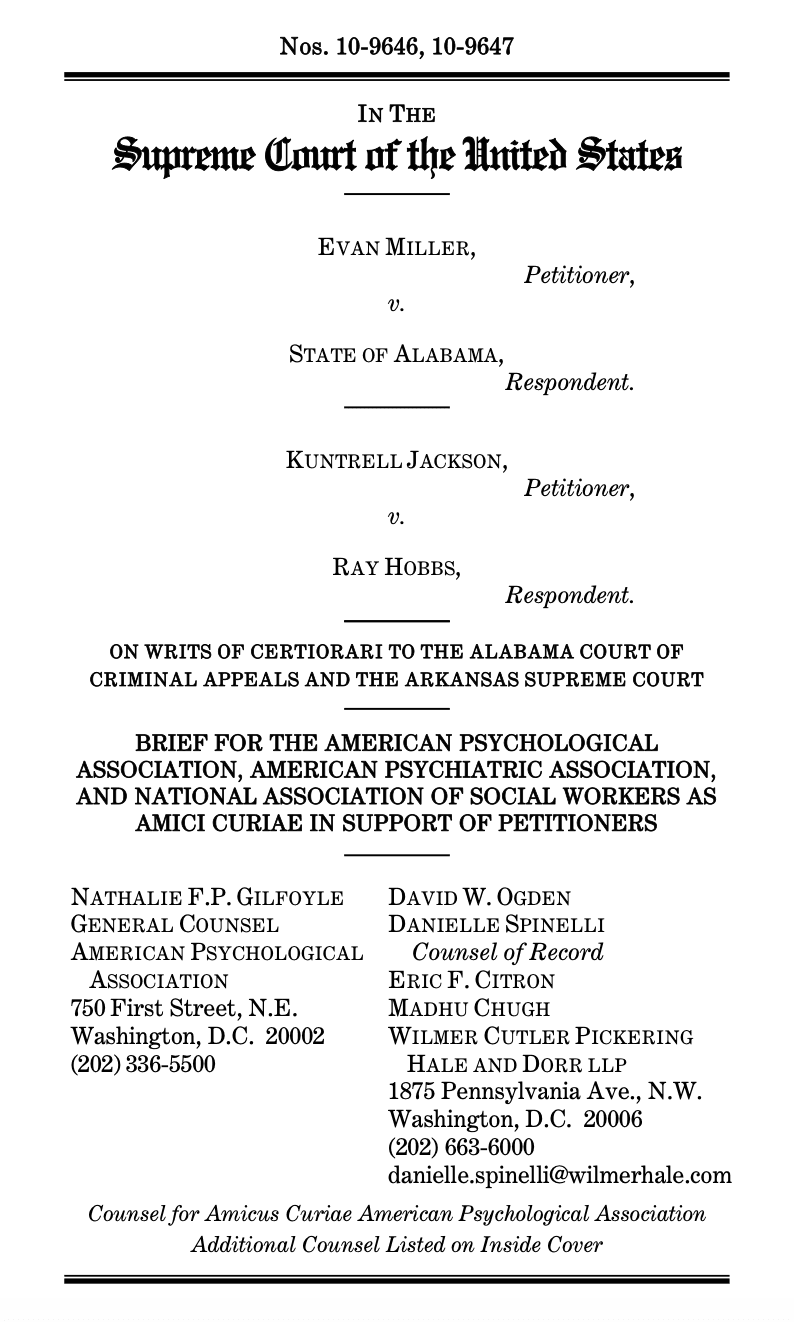
Summary of Argument
In Graham v. Florida, 130 S. Ct. 2011 (2010), this Court held that the Eighth Amendment prohibited life sentences without the possibility of parole for juveniles convicted of non-homicide offenses. The special charac- teristics of juveniles that this Court identified in Graham—and that are supported by a large and growing body of research—apply equally to juveniles convicted of homicide offences.
In Graham, this Court reiterated the critical differences between juveniles and adults that it set out in Roper v. Simmons, 543 U.S. 551 (2005)—differences that do not absolve juveniles of responsibility for their crimes, but that do reduce their culpability and undermine any justification for definitively ending their free lives. The Court noted that juveniles lack adults’ capacity for mature judgment; that they are more vulner- able to negative external influences; and that their characters are not yet fully formed. Graham, 130 S. Ct. at 2026-2027; Roper, 543 U.S. at 569-570, 573. “The sus- ceptibility of juveniles to immature and irresponsible behavior means ‘their irresponsible conduct is not as morally reprehensible as that of an adult.’” Roper, 543 U.S. at 570. Juveniles’ vulnerability and lack of control over their surroundings “mean juveniles have a greater claim than adults to be forgiven for failing to escape negative influences in their ... environment.” Id. And “[j]uveniles are more capable of change than are adults,” meaning that “their actions are less likely to be evidence of ‘irretrievably depraved character,’” even in the case of very serious crimes. Graham, 130 S. Ct. at 2026-2027; see Roper, 543 U.S. at 570. Accordingly, “[t]he juvenile should not be deprived of the opportu- nity to achieve maturity of judgment and self- recognition of human worth and potential”—with “no chance to leave prison before life’s end”—because “[m]aturity can lead to that considered reflection which is the foundation for remorse, renewal, and rehabilita- tion.” Graham, 130 S. Ct. at 2032.
As was true in Graham, “[n]o recent data provide reason to reconsider the Court’s observations in Roper about the nature of juveniles.” 130 S. Ct. at 2026. Rather, “developments in psychology and brain science continue to show fundamental differences between ju- venile and adult minds.” Id. In fact, an ever-growing body of research in developmental psychology and neu- roscience continues to confirm and strengthen the Court’s conclusions. Compared to adults, juveniles are less able to restrain their impulses and exercise self- control; less capable of considering alternative courses of action and avoiding unduly risky behaviors; and less oriented to the future and thus less attentive to the consequences of their often-impulsive actions. Re- search also continues to demonstrate that “juveniles are more vulnerable or susceptible to negative influ- ences and outside pressures, including peer pressure,” while at the same time they lack the freedom and autonomy that adults possess to escape such pressures. Roper, 543 U.S. at 569. Thus, even after their general cognitive abilities approximate those of adults, juve- niles are less capable than adults of mature judgment and decision-making, especially in the social contexts in which criminal behavior is most likely to arise.
Moreover, because juveniles are still in the process of forming coherent identities, adolescent crime often reflects the “signature”—and transient—“qualities of youth” itself, Roper, 543 U.S. at 570, rather than an en- trenched bad character. Research into adolescent de- velopment continues to confirm the law’s intuition that “‘incorrigibility is inconsistent with youth.’” Graham, 130 S. Ct. at 2029. And although some youthful offend- ers will develop into criminal adults, it remains essen- tially impossible “even for expert psychologists to dif- ferentiate between the juvenile offender whose crime reflects unfortunate yet transient immaturity, and the rare juvenile offender whose crime reflects irreparable corruption.” Roper, 543 U.S. at 573. As Roper recognized, that is true even of juvenile offenders who have committed the most serious crimes.
Recent neuroscience research suggests a possible physiological basis for these recognized developmental characteristics of adolescence. It is increasingly clear that adolescent brains are not yet fully mature in regions and systems related to higher-order executive functions such as impulse control, planning ahead, and risk avoid- ance. That anatomical and functional immaturity is consonant with juveniles’ demonstrated psychosocial (that is, social and emotional) immaturity. During puberty, juveniles evince a rapid increase in reward- and sensa- tion-seeking behavior that declines progressively throughout late adolescence and young adulthood. This effect is amplified by exposure to peers, and it corre- sponds with significant changes in certain elements of the brain’s “incentive processing system”—especially the parts that process rewards and social cues. By contrast, the ability to resist emotional impulses and regulate behavior develops gradually throughout adolescence, and that behavioral development corresponds with gradual development of the brain structures and systems most involved in executive function and impulse control. The disjunction between these developmental processes— which is greatest in early and middle adolescence and narrows as individuals mature into young adulthood—is consistent with the familiar features of adolescence that this Court recognized in Roper and Graham.
In short, research continues to confirm and expand upon the fundamental insight underlying this Court’s previous decisions: Juveniles’ profound differences from adults undermine the possible penological justifi- cations for punishing a juvenile offender with a sen- tence that “guarantees he will die in prison without any meaningful opportunity to obtain release.” Graham, 130 S. Ct. at 2033. Nor does the scientific literature provide any reason to distinguish between homicide and non-homicide convictions in this regard. In either case, the signature qualities of adolescence reduce ju- veniles’ culpability and increase their capacity for change. Condemning an immature, vulnerable, and not-yet-fully-formed adolescent to live every remaining day of his life in prison—whatever his crime—is thus a constitutionally disproportionate punishment.